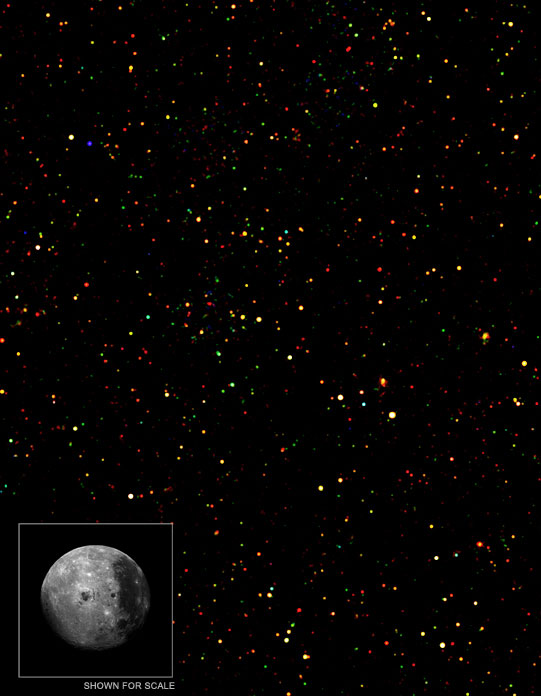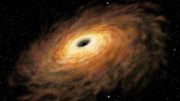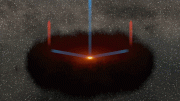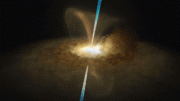
A Chandra X-Ray Observatory image of a field of galaxies in the constellation Bootes. A new study of 703 galaxies with supermassive black holes in this field finds that although infrared from dust and X-ray emission from the nucleus tend to be correlated, the infrared emitted by the supermassive black holes is not well correlated with the dust, suggesting the role of our viewing angle of a torus around the black hole nuclei. Credit: X-ray: NASA/CXC/CfA/R.Hickox et al.; Moon: NASA/JPL
All massive galaxies are believed to host supermassive black holes (SMBH) at their centers that grow by accreting mass from their environment. The current picture also imagines that the black holes grow in size as their host galaxy evolves, perhaps because galaxy evolution includes accretion triggered, for example, by galaxy mergers.
This general picture has been substantiated by two lines of data. The peak epoch of black hole accretion can be measured by observations of nuclear activity, and coincides with the peak epoch of star formation in the universe about ten billion years after the big bang. Star formation is associated with disruptions that stir up the gas and induce accretion. Moreover, the local universe shows a tight correlation between SMBH mass, host galaxy bulge mass, and the spread of stellar velocities.
These methods (but with weaker confirmation) can similarly estimate the sizes of SMBH in galaxies in the earlier universe, and find that SMBH growth and galaxy growth are co-evolutionary processes. Indeed, it seems the processes may regulate each other over time to produce the galaxy and SMBH sizes we observe today.
Both central black hole growth and star formation are fed by the abundance of molecular gas and dust that can be traced by the infrared emitted by the dust. Dust grains, heated by the radiation from young stars and active galactic nucleus (AGN) accretion, emit strongly in the infrared. Since AGN activity also produces X-rays, the expectation is that AGN should track strong dust emission and that X-ray and infrared emission should be correlated.
Harvard-Smithsonian Center For Astrophysics (CfA) astronomer Mojegan Azadi was a member of a team that examined 703 galaxies with active SMBH nuclei using both X-ray data from Chandra and infrared from Spitzer and Herschel, the largest sample to date making this comparison. Although the team did find a trend consistent with the infrared correlating with AGN X-ray activity over a wide range of cases, they did not find one when compared with the AGN’s infrared (not- X-ray) contributions. Since the AGN infrared comes largely from a dusty emitting torus around the SMBH, the difference could point to the role of the angle with which we view the torus.
These results help to refine the current models of AGN activity, but the authors note that more sensitive, deeper observations should be able to sort out more clearly the physical processes associated with the AGN.
Reference: “Infrared Contributions of X-Ray Selected Active Galactic Nuclei in Dusty Star-forming Galaxies” by Arianna Brown, Hooshang Nayyeri, Asantha Cooray, Jingzhe Ma, Ryan C. Hickox and Mojegan Azadi, 24 January 2019, The Astrophysical Journal.
DOI: 10.3847/1538-4357/aaf73b









Be the first to comment on "New Results Help Refine Current Models of AGN Activity"